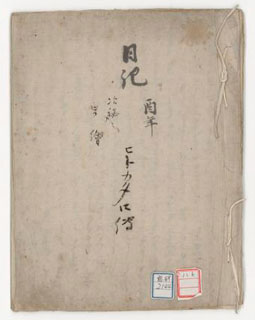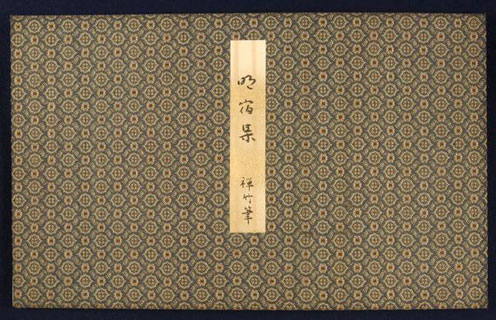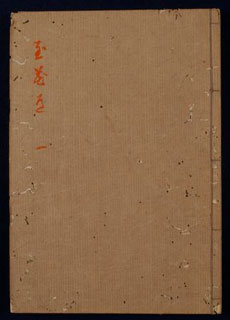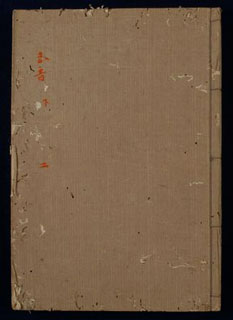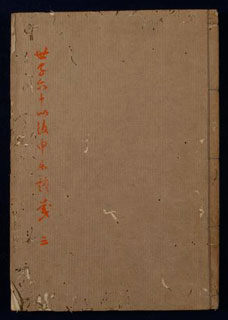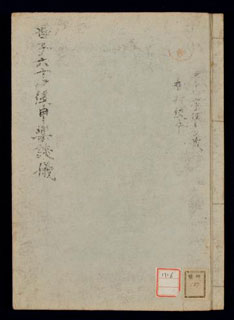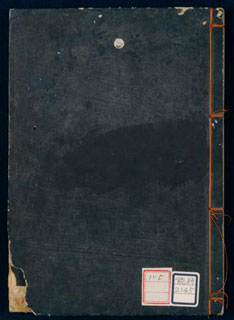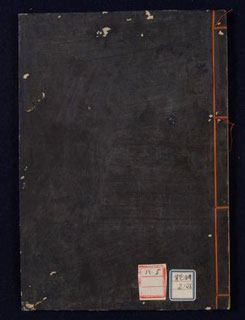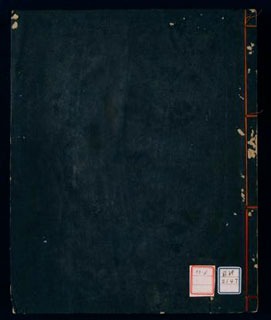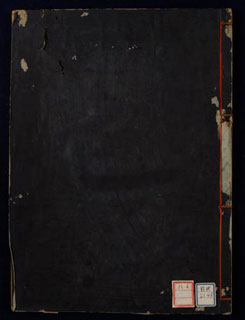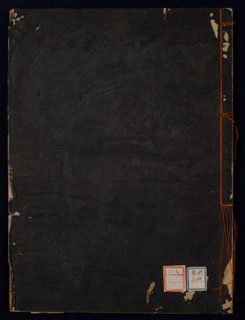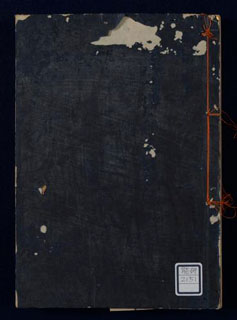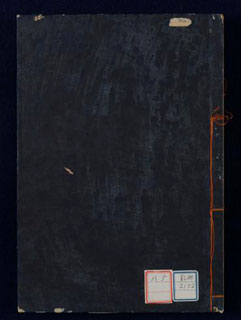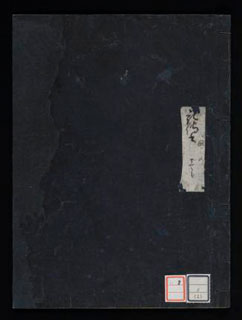Nō Treatises
The history of nō’s treatises goes back as far as the 15th century; Zeami (1363?-1443) was the first person to have left writings on various teachings to his sons, ranging from practical methods of acting, singing, training, and playwriting, to more conceptual, abstract observations of how nō plays should be performed. Konparu Zenchiku (1405-70?), Zeami’s son-in-law and head of the Konparu troupe, inherited a few of Zeami’s treatises, but instead of practical tips, he wrote treatises discussing religious and spiritual conceptualizations of nō. The writing of treatises spread not only among actors but also among musicians in later years. The transmission of treatises meant the succession of lineage, and generations of nō performers have copied and transmitted the materials they received from their masters, including verbatim records. Since lessons were open to non-professionals, the receivers of knowledge were not limited to professional performers, but also included privileged amateurs such as daimyō (provincial warlords) and those with connections to the daimyo. Such people could also access these materials, resulting in the authors, copiers, and former owners of many of the extant treatises today.
-
- Title:
- Figure Drawings of the Two Arts and the Three Modes
- Title (jp):
- Nikyoku santai ningyōzu 二曲三体人形図
- Description:
- Completed in 1421 (Ōei 28), this treatise by Zeami discusses in detail the two arts (singing and dancing) and three modes (Aged, Woman’s, and Martial) that he claims as the important archetypes for nō acting. The treatise includes drawings of nine figures, including the child, demons (oni), and heavenly maiden (tennyo), in addition to the basic three (old man, woman, and warrior). Dance style and epigraphs describing each figure are written together to indicate the ideal posture or state of mind of the actor.
This handwritten manuscript by Konparu Zenchiku is a karitoji-bon (“book with temporary binding”) of 26.7 x 20.7 cm, with the title “Nikki hitokata kuden” (“Diary: Oral Transmission on Acting Figures”) on its cover. The last few lines of the Figure Drawings are lost. Also included are fragments from the “Separate Pages of Oral Instructions” from the seventh section of Transmitting the Flower through Effects and Attitudes (usually called Kaden dainana besshi kuden) and Sazen nikki, a diary by Fujiwara Saneshige (fl. 13th century). - Collection name:
- Noh Theatre Research Institute
- Volume:
- 1
-
- Title:
- A Secret Transmission Regarding the Okina Deity
- Title (jp):
- Meishukushū 明宿集
- Description:
- Discovered in 1964 (Shōwa 39) from the family archive of the iemoto (“head”) of the Konparu family, this book was originally comprised of 11 sheets of paper, which were later bound as an orihon (“folded book”). 30.5 x 49.2 cm. Although without a colophon, it is assumed to be dated in Konparu Zenchiku’s later years, circa 1465 (Kanshō 6).
This treatise, handwritten by Zenchiku, discusses the origin of the sacred Okina (翁), an important deity to nō performers. Ranging from Okina’s origin to the Okina mask and dance, Zenchiku discusses the religious and spiritual importance of Okina. In his extensive discussion, Zenchiku claims Okina as the incarnation of Shukujin (宿神), a deity with roots in Buddhist ritual who also embodies various sacred beings from kami worship (more popularly known as Shintō) and Buddhism. Zenchiku’s esoteric discussion shows his broad interest in, and profound knowledge of, medieval religion and poetry. - Collection name:
- Hosei University Kōzan Collection
- Volume:
- 1
-
- Title:
- A Course to Attain the Flower, Hosokawa Collection of Ten Treatises
- Title (jp):
- Hosokawa jūbu densho Shikadō 細川十部伝書 至花道
- Description:
- Completed in 1420 (Ōei 27), this treatise by Zeami is a brief but important text representative of Zeami’s thought in his middle years. He discusses five topics: “On the Two Arts and the Three Modes,” “On Failing to Bring the Subject into Effect,” “On the Rank of Great Virtuosity,” “On Skin, Meat and Bones,” and “On Substance and Instance.”
According to the colophon, this book is a copy of Myōan Gentaku’s book, which was itself a copy made by Gentaku in 1598 (Keichō 3) of a book possessed by his father, Hosokawa Yūsai (1534-1610). Hosokawa Yūsai was a warrior and poet with political and cultural connections to the Ashikaga Shogun family, Oda Nobunaga, Toyotomi Hideyoshi, and Tokugawa Ieyasu. - Collection name:
- Hosei University Kōzan Collection
- Volume:
- 1
-
- Title:
- Five Sorts of Singing, Vol. 2, Hosokawa Collection of Ten Treatises
- Title (jp):
- Hosokawa jūbu densho Goon (ge) 細川十部伝書 五音(下)
- Description:
- Goon is an anthology of nō chanting pieces written and compiled by Zeami. It is helpful in identifying song composers or lyric writers of plays, since their names are recorded together with the fragments of chants. Compiled in the second (ge) volume are songs classified as rangyoku, which require the ultimate level of virtuosity among the five sorts of singing, as well as an explanation of kusemai singing. This book is also a copy of Myōan Gentaku’s book, which Gentaku copied in 1598 (Keichō 3) from his father Hosokawa Yūsai.
- Collection name:
- Hosei University Kōzan Collection
- Volume:
- 1
-
- Title:
- Discussions on Sarugaku by Zeami in His Sixties, Hosokawa Collection of Ten Treatises
- Title (jp):
- Hosokawa jūbu densho Zeshi rokujūigo sarugaku dangi 細川十部伝書 世子六十以後申楽談儀
- Description:
- As the title shows, this is one of the later treatises by Zeami, written after he reached sixty. Recorded by Zeami’s second son Motoyoshi, the discussion varies from Zeami’s impressions of his predecessors and contemporaries to meticulous creative efforts in performances, tips on writing plays, and the development of nō troupes. This Hosokawa collection version, however, does not include the content in its entirety and has many omissions. On the last page of the book, the owner Hosokawa Yūsai adds that he borrowed the book from Tokugawa Ieyasu and copied it himself.
- Collection name:
- Hosei University Kōzan Collection
- Volume:
- 1
-
- Title:
- Discussions on Sarugaku by Zeami in His Sixties, former Kurokawa Harumura Collection
- Title (jp):
- Kurokawa Harumura kyūzō Zeshi rokujūigo sarugaku dangi 黒川春村旧蔵「世子六十以後申楽談儀」
- Description:
- Kurokawa Harumura (1799-1866), former owner of the book, was a kokugaku (“national learning”) scholar devoted to Japanese phonology and grammar. According to the colophon, the original book belonged to Ryūtei Tanehiko (1783-1842), a popular fiction writer, and was presumably copied multiple times before falling into Kurokawa’s hands. Marginalia in red are by Kurokawa, and show his scholarly attitude toward the book.
- Collection name:
- Noh Theatre Research Institute
- Volume:
- 1
-
- Title:
- Transmitting the Flower Through Effects and Attitudes, Hachizaemon Manuscript
- Title (jp):
- Fūshi kaden (Hachizaemonbon) 風姿花伝(八左衛門本)
- Description:
- Ōhon (27.0 x 20.4 cm), fukurotoji binding. Completed in 1418, Fūshi kaden is Zeami’s earliest and most famous treatise, begun in his thirties. It is an important resource for learning about Zeami’s basic ideas of performance and for considering how his theories developed later. The complete treatise consists of seven sections, but this Hachizaemon manuscript copies Fūshi kaden only up to the fifth section. The owner and copier of this manuscript, Konparu Hachizaemon Yasuyoshi (1588-1661), was the second son of Konparu Yasuteru (1549-1621), the head of the Konparu troupe, and established his own branch family.
- Collection name:
- Noh Theatre Research Institute
- Volume:
- 1
-
- Title:
- A Course to Attain the Flower, Hachizaemon Manuscript
- Title (jp):
- Shikadō (Hachizaemonbon) 至花道(八左衛門本)
- Description:
- Hanshibon (approx. 24 x 17 cm), fukurotoji binding. Copied by Konparu Hachizaemon Yasuyoshi. As with the Fūshi kaden from the same Hachizaemon manuscript, the colophon notes how, due to the early passing of his older brother Ujikatsu (1576-1610), Yasuyoshi’s father left the treatises to his descendants as the family’s secret transmission.
- Collection name:
- Noh Theatre Research Institute
- Volume:
- 1
-
- Title:
- Pick Up the Jewel and Take the Flower in Hand
- Title (jp):
- Shūgyoku tokuka 拾玉得花
- Description:
- Ōhon (27.0 x 20.4 cm), fukurotoji binding. The treatise was directly transmitted from Zeami to his son-in-law Konparu Zenchiku in 1428 (Shōchō 1). It takes a question-and-answer format to address abstract and philosophical ideas on what makes a successful performance and actor. This is the only extant manuscript for the treatise, and annotations and readings of the characters are written in red ink. Copied by Konparu Hachizaemon Yasuyoshi.
- Collection name:
- Noh Theatre Research Institute
- Volume:
- 1
-
- Title:
- An Account of the Six Spheres and Single Dewdrop
- Title (jp):
- Rokurin ichiro no ki 六輪一露之記
- Description:
- Ōhon (27.0 x 20.4 cm), fukurotoji binding. Written around 1455 (Kōshō 1), this treatise by Konparu Zenchiku discusses the six substances of nō represented by circles (spheres) and a dewdrop that is ultimately equated with a sword. Instead of providing practical tips for performance, the treatise demonstrates Zenchiku’s explorations of nō ideals as philosophical concepts. Also bound together in this book are “Rokurin ichiro no kichū,” an annotation for the original treatise, and “Inariyama sanrōki” by the same author. Copied by Konparu Hachizaemon Yasuyoshi.
- Collection name:
- Noh Theatre Research Institute
- Volume:
- 1
-
- Title:
- Abstract for Attaining the Way
- Title (jp):
- Shidōyōshō 至道要抄
- Description:
- Ōhon (27.0 x 20.4 cm), fukurotoji binding. Zenchiku completed this treatise in his last years, circa 1467 (Ōnin 1). In the first half, he discusses eight types of singing, and in the second half, he applies the Buddhist concept of threefold training (in virtue, mind, and wisdom) to three types of yūgen (“grace” or “subtlety”), and further attempts to fuse these with his fundamental aesthetics of “six spheres and a dewdrop.” The treatise represents the final stage of Zenchiku’s philosophical theorization of nō inspired by Zeami. Copied by Konparu Hachizaemon Yasuyoshi from Zenchiku’s original manuscript held at Hōzanji temple.
- Collection name:
- Noh Theatre Research Institute
- Volume:
- 1
-
- Title:
- The Essence of Song and Dance
- Title (jp):
- Kabu zuinōki 歌舞髄脳記
- Description:
- Hanshibon (16.5 x 23.5 cm), fukurotoji binding. In this treatise, completed in 1456 (Kōshō 2), Zenchiku attempts further development of Nine Ranks (Kyūi), Zeami’s treatise discussing the hierarchy of achievements in performance. Zenchiku demonstrates each phase of ideal achievement by referring concretely to plays and by quoting relevant famous waka and kanshi poems. Copied by Konparu Hachizaemon Yasuyoshi.
- Collection name:
- Noh Theatre Research Institute
- Volume:
- 1
-
- Title:
- Three Turns Around the Five Sorts of Singing
- Title (jp):
- Goon sangyoku shū 五音三曲集
- Description:
- Hanshibon (16.5 x 23.5 cm), fukurotoji binding. In this treatise completed in 1458 (Kōshō 4), Zenchiku takes Zeami’s concepts of “five sorts of singing” and “skin, meat, and bones” and attempts to develop them further by classifying chanting into 26 types. The treatise contains practical and philosophical discussion and can be considered a forerunner to Zenchiku’s treatise Abstract for Attaining the Way (Shidōyōshō). Copied by Konparu Hachizaemon Yasuyoshi. Notes in red ink are also considered a faithful copy of Zenchiku’s original manuscript.
- Collection name:
- Noh Theatre Research Institute
- Volume:
- 1
-
- Title:
- Technical Specifications for the Five Sorts of Singing
- Title (jp):
- Goon no shidai 五音之次第
- Description:
- Hanshibon (16.5 x 23.5 cm), fukurotoji binding. Zenchiku completed this treatise in 1455 (Kyōtoku 4) according to the colophon. He paraphrases Zeami’s ideas of “five sorts of singing,” and demonstrates his understanding, for example, through direct quoting of chanting phrases. This belongs among the earliest of similar treatises by Zenchiku on nō chanting, such as Three Turns Around the Five Sorts of Singing and Abstract for Attaining the Way. Copied by Konparu Hachizaemon Yasuyoshi.
- Collection name:
- Noh Theatre Research Institute
- Volume:
- 1
-
- Title:
- Eight-Volume Kadensho, movable type
- Title (jp):
- Kokatsuji-ban Hachijōbon Kadensho 古活字版『八帖本花伝書』
- Description:
- Ōhon (27.0 x 20.4 cm), fukurotoji binding, movable type. Thought to have been printed in the late Keichō era (early 17th century). Although titled Kadensho (an alternative name for Fūshi kaden, Zeami’s most famous treatise), the treatise includes only small sections from Zeami’s treatises; it is rather a compilation of miscellaneous treatises from various lineages in the late Muromachi period (16th century). Although its authenticity as a treatise remains doubtful today, this book includes detailed practical tips for stage performance from the late Muromachi period, both in acting and playing nō music.
- Collection name:
- Noh Theatre Research Institute
- Volume:
- 8
- View all

